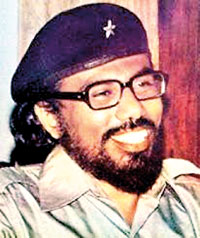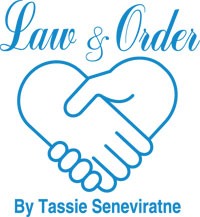Sunday Times 2
Subterfuge and betrayal of youth aspirations led to wars in Sri Lanka
View(s):
JVP founder Rohana Wijeweera: Communist to the core
The Janatha Vimukthi Peramuna (JVP), a Communist and Marxist-Leninist Party, was founded by Rohana Wijeweera around 1964.
Rohana Wijeweera’s father had been a political activist of the Communist Party of Sri Lanka (CPSL). During an election campaign in the 1960s he had been severely assaulted by thugs of the ruling UNP and as a consequence become paralysed. This had affected Young Rohana emotionally.
Rohana’s education had been in jeopardy as a result of his father’s incapacitation. The CPSL had risen to the occasion and arranged a scholarship for him to study medicine in the Patrice Lumumba University in Moscow. There, he had read the works of Karl Marx, Fredrich Engels and Lenin and become a committed Marxist.
By this time the Communist Party in Sri Lanka had divided into two factions – the Chinese faction and the Soviet faction. Rohana had broken from the CPSL which was aligned to USSR and joined the Maoist-aligned Ceylon Communist Party (CCP). It was then led by N. Shanmuganathan.
After a visit to Sri Lanka, Rohana had not been permitted to return to the USSR due to his favour with the Maoist line. He could have renewed his visa if he toed the USSR line. But Rohana was made of harder stuff.
Back in Sri Lanka, he felt that the Left movement (The Old Left) had failed to deliver and decided to start from scratch to suit the Sri Lanka working class. This was in contrast to most political parties which broke off from established parties. He found that the leaders of the Old Left were leading bourgeoisie lives. I refrain from commenting on the pros and cons of his political ideology, but he was able to increase political awareness of the working class.
There were the famous five classes conducted by the indefatigable Rohana himself, and by 1971, the JVP had established itself as a political party to reckon with and offered an alternative to those disillusioned with politics of the other Left organisations. Majority of members and supporters at that time were the young adult group. The Government and its Left allies were alarmed at the political potential and the political challenge of the JVP, and levelled trumped up allegations against the fledging party and by way of subterfuge planned to suppress it. The JVP’s intelligence sources were equal to the task and being wise to their sinister plans, started preparing to counter a violent eventuality that would ensue, and violence escalated din-dong.
A senior former from a leading school in Kandy acquired the knowhow to manufacture bombs from a forensic book in the British Council Library and passed it on to his accomplices in the Peradeniya University and elsewhere. Victor Ivan a.k.a. Podi Athula received severe injury to his hand from an accidental explosion when demonstrating bomb manufacture. There were more accidental explosions in the Jayathilake Hall ceiling at the Peradeniya Campus and at Nelumdeniya.
Prime Minister Sirimavo Bandaranayake had hitherto not taken the JVP threat seriously. She is reported to have scoffed at it saying, “Can these juveniles raiding kadgu-puhulang (Cashew fruit) trees topple a government.”
 With these accidental explosions, the government took the threat seriously and began to arrest and incarcerate JVP members. Rohana Wijeweera, too, was arrested. The suppression, however, drove the JVP to militancy and the Insurrection of 1971 that ensued.
With these accidental explosions, the government took the threat seriously and began to arrest and incarcerate JVP members. Rohana Wijeweera, too, was arrested. The suppression, however, drove the JVP to militancy and the Insurrection of 1971 that ensued.
In 1987-1989 the JVP exploited the unpopularity of the arrival of the Indian Peace-Keeping Force and rose in revolt. It started with the killing of government party politicians and as it gathered momentum went on to kill supporters and sympathisers of other political parties, businessmen, Police and Armed Services personnel and finally families of police and Armed Services personnel. All and sundry obeyed a mere JVP chit and people handed over without resistance, whatever was demanded. Other criminals too cashed in on JVP name and committed robberies and a state of anarchy prevailed.
At this stage, private citizens, public officials, politicians of different hues, Police and Armed Services personnel, all joined together into unofficial groups and annihilated the JVP leadership and many of its members.
The JVP has since entered the democratic election process.
The Eelam War
In the 1956 Parliamentary Elections, the MEP-led by S.W.R.D. Bandaranaike (SWRD) promising to make Sinhala the only official language romped in with a thumping majority and introduced the Official Language Act making Sinhala the only Official Language. This was widely opposed by the Tamil people and the Federal Party led by S.J.V. Chelvanayakam threatened direct action. To appease the Tamil people, SWRD signed the Bandaranaike-Chelvanayakam Pact advocating the creation of Regional Councils as a means to giving a certain level of autonomy to the Tamil people. This pact was opposed by Sinhalese extremists and was eventually torn up by Prime Minister SWRD in May 1958.
Later attempts by Prime Ministers of the UNP and the SLFP to pass similar legislation were opposed by the opposition party and incited the Sinhalese extremists. Realising the futility of pacts with Sinhalese-dominated governments, the Tamil United Liberation Front (TULF) comprising the Federal Party, the Tamil Congress and other Tamil groups, unanimously endorsed the now famous ‘Vaddukoddai Resolution’.
This resolution articulated, inter alia, the view that the minority Sri Lankan Tamils needed separation from the rest of Sri Lanka to resolve their political problems, and resolved to, “restore and reconstitute the State of Eelam in order to safeguard the very existence of the Tamil Nation in this country”. The resolution also went on to state: “This convention directs the Action Committee of the Tamil United Liberation Front to formulate a plan of action and launch without undue delay the struggle for winning the sovereignty and freedom of the Tamil Nation: and “this convention calls upon the Tamil Nation in general and the Tamil Youth in particular to come forward and throw themselves fully into the sacred fight for freedom and to flinch not till the goal of a sovereign state of Eelam is reached.”
This led to the decades-long Eelam War waged by the Liberation Tigers of Tamil Eelam (LTTE) which ended only in May 2009 with the crushing of the LTTE by Government forces. But the communal problem is still simmering.
It may be noted that the Prime Ministers of Sinhalese dominated SLFP and UNP governments agreed with the demands of the Tamil people accepting them as just and fair, but reneged on it due to political expediency. It is unfortunate that none of them has displayed statesmanship enough to contain the extremist elements and go through with a lasting solution.
(The writer is a Retired Senior Superintendent of Police. He can be contacted at seneviratnetz@gmail.com)

